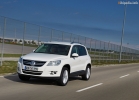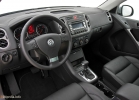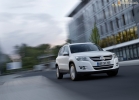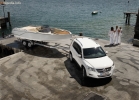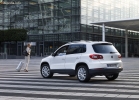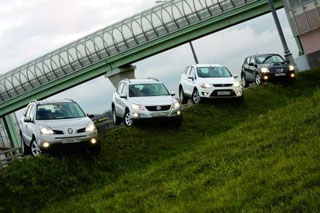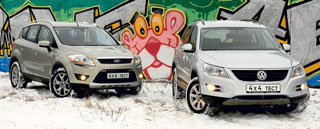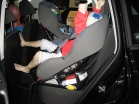Volkswagen Tiguan test drive since 2008 SUV
A little bit of everything
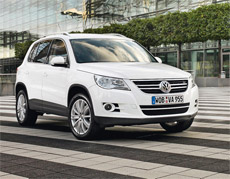 It is good for freshmen at the beginning of the school year: everyone is in equal terms, no one knows anyone, the company has not yet managed to form a much harder to join the team of the course in the fourth, when the interests of interests have already formed.
It is good for freshmen at the beginning of the school year: everyone is in equal terms, no one knows anyone, the company has not yet managed to form a much harder to join the team of the course in the fourth, when the interests of interests have already formed. Relax vehicles get into the class with a long-built hierarchy, the determined leaders are also not easy. So, in order to gain a foothold in the segment, where Honda CR-V and Toyota Rav4 dominate for many years, Volkswagen needed to offer the consumer something special. And the Germans began with the fact that they came up with an interesting name Tiguan. Indeed, the funny name that combines in itself, as has repeatedly reported in the press, the words of the Tiger and Iguan. But if everything is clear with the tiger (for sure, in this way, marketers decided to demonstrate the very serious intentions of the first compact SUV VW), then the second part of the name is puzzling: what does Iguan have to do with it? We dare to suggest that the developers wanted to emphasize the freshness and dynamism of their brainchild, and possibly tried to cause positive associations with the same Iguan word with the word of iguan with the same name of the youth clothing brand. Be that as it may, even a good name will not help if it belongs to a medium car. However, Tiguan is clearly not the case: this is a solid, high -quality, competently designed and coolly realized SUV, which claims leadership in his segment. Yes, the Germans were delayed, but the right calculation and the inconspicuous approach allowed the car to take a worthy position in the segment.
General impressions
Tiguan is not a ladies' car, it does not seem frivolous, but not a massive vehicle for a skinny bandit in a leather jacket. In general, what is necessary. The salon makes an equally pleasant impression: the ergonomics is wonderful, typical for Volkswagen, high -quality decoration materials. However, outwardly, the car is still quite boring, you can even say averaged (reminiscent of other brand models). Well, let, for a person who chose Volkswagen, the main convenience, and it is pleasant to use the equipment offered by the developers, as well as to sit in the coolly provided front chairs.
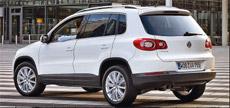 As for the running qualities, Tiguan is certainly one of the leaders of his class. It accelerates quite assertively with any engine, and, more importantly, it slows down effectively, exactly, accurately and confidently. And how to steer! At least annoying snaps, the car does what is required of it. Alas, the smoothness of the course suffers greatly (in this class there are much more comfortable cars). Cracability also cannot be called a strong side of the model: where the roads end, many competitors will overtake Tiguan, and above all because of the small road clearance of the German SUV.
As for the running qualities, Tiguan is certainly one of the leaders of his class. It accelerates quite assertively with any engine, and, more importantly, it slows down effectively, exactly, accurately and confidently. And how to steer! At least annoying snaps, the car does what is required of it. Alas, the smoothness of the course suffers greatly (in this class there are much more comfortable cars). Cracability also cannot be called a strong side of the model: where the roads end, many competitors will overtake Tiguan, and above all because of the small road clearance of the German SUV. Choosing a body
There is nothing to talk about here: the body is one, without options, a five -door station wagon. True, not all versions look the same: the base model is quite aggressive, while the SUV TRACK & FELD off -road package makes noticeable changes to the exterior (in particular, the front bumper looks different, it hangs a little lower in asphalt modification, and in general it seems more fleshy ).
Characteristics
Type of body SUV
The number of doors 5
Sum of places 5
Length 4427-4457 mm
Width 1809 mm
Height 1686 mm
Wheel base 2604 mm
The type of suspension (lane/back) is independent, with racks like MacPherson/independent, multi -link
Type of drive front or complete
Brakes (per./Back.) Discollated/disk disk
Gas tank volume 64 liters
Passive safety rating*
Adult protection *****
Children's protection ****
Pedestrian protection **
* According to EURONCAP.
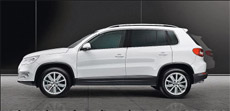 Sources of movement
Sources of movement The weakest of the engines offered for Tiguan are a small masterpiece named 1.4 TSI: thanks to double boost (the engine is simultaneously equipped with a mechanical supercharger and turbocharger), it develops 150 hp. This is enough to disperse the car (according to the manufacturer) to hundreds of only 9.6 s (the maximum speed with this power unit is 192 km/h). Note that Tiguan with the 1.4 TSI engine is the only modification that goes both with front and all -wheel drive. The option with the front leading wheels will cost 850 thousand rubles, while an all -wheel drive machine with the same engine will cost 54 thousand more. An exclusively 6-speed manual gearbox is available for this model.
The next power of the gasoline power unit is the deformed version of the 2.0 TFSI engine (instead of 200 horses, only 170 in it). It joins only with a 6-speed automatic transmission, and, according to passport data, the dynamics is even inferior to 1.4 TSI motor (up to hundreds of the car accelerates in 9.9 s, the maximum speed of 197 km/h). There is nothing to be done: once you are too lazy to switch the programs yourself, you have to put up with the worst acceleration dynamics. And with a more impressive price tag: this Tiguan will cost already 1,054 thousand rubles.
The least powerful (but at the same time most expensive) engine is a 2-liter diesel engine, developing 140 hp. As well as for a car with a 2-liter gasoline turbo engine, only one automatic box with six ranges is possible. The minimum cost of such a machine is 1,097 thousand rubles.
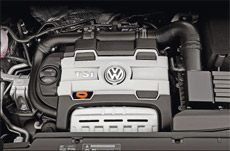 Basic levels of equipment
Basic levels of equipment The easiest Tiguan Trend & Fun, supplied only with the 1.4 TSI engine (price 850 thousand rubles, as mentioned above). Even in this performance, the SUV is well equipped: in the base there are mirrors with electric drive and heating, decent music, two -zone climate control, a complete arsenal of airbags (front, side, as well as inflatable curtains), the stabilization system, coupled with ABS and anti -tuxes device, heating the front seats , adjusting the driver's seat in height and much more.
Buyer who spent 904 thousand rubles. For a car with a 1.4 TSI engine, in the TRACK & Field configuration, in addition to the all -wheel drive, the tire pressure sensor, the front seats, a parking radar, a more perfect audio system, alloy wheels, and in addition, are many pleasant trifles such as sliding drawers in the front boxes chairs. In terms of equipment, Sport & Style practically does not differ from Track & Field, well, perhaps the upholstery of the seats is different, and around the previous configuration, chrome moldings are installed around the previous configuration. There is no difference in price: with any engine, the cost will be the same. The main differences in the exterior. Track & Field execution with an off -road slope, and that is why the front bumper is less impressive, but it provides a cooler entry angle compared to Sport & Style (28 instead of 18). Modifications with more powerful power units practically do not differ from the younger versions in terms of equipment: all standard positions are similar. The only thing the motor affects the cost of the machine. As already mentioned, the 2-liter gasoline engine increases the price to 1,054 thousand rubles, and diesel of the same volume to 1,097 thousand rubles.
Additives?
Tiguan can be seriously modified for the surcharge. For example, to paint an all -terrain vehicle with an enamel type of metallic or mother -of -pearl (it will cost about 12 thousand rubles).
Buyers of cars with a 1.4 TSI engine (in any design, except Trend & Fun) for 36,552 rubles. It is proposed to receive your car with a pre -heater with remote control. Each model can be equipped with sports seats, sheathed skin, and the driver's seat is equipped with an electric drive. True, the price of this pleasure will depend on the performance of the version. For example, for the basic Tiguan, the cost will be over 84 thousand rubles, for Track & Field, the price will decrease to 76 thousand, and for Sport & Style the option will cost only 68 thousand.
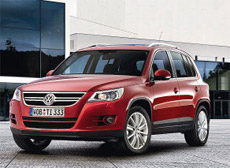 For a spare wheel (the so -called doktka), a set of tools and a jack should only be paid 5168 rubles. A little more expensive than 8246 rubles. There is a package of light and a review, which includes the rain sensor, folding external mirrors, as well as an intra -sulfate mirror with auto -damping. And in order to be good at any time and on any road, you will have to spend 43,300 rubles. On adaptive bixenon headlights with a washer. Expensive, but they are worth it.
For a spare wheel (the so -called doktka), a set of tools and a jack should only be paid 5168 rubles. A little more expensive than 8246 rubles. There is a package of light and a review, which includes the rain sensor, folding external mirrors, as well as an intra -sulfate mirror with auto -damping. And in order to be good at any time and on any road, you will have to spend 43,300 rubles. On adaptive bixenon headlights with a washer. Expensive, but they are worth it. Any Tiguan can be planted on 17-inch wheels with wide (235 /55 R17) rubber. Moreover, if Track & Field & Style will be able to finish such wheels for 15 thousand rubles, then the basic version of Trend & Fun will be able to equip 27 thousand with a tail, because the machine is initially provided for the car.
Those who can afford perhaps the basic version of Trend & Fun, equipped not as perfect musical installation as other models, for only 3 thousand rubles. With a small one, the SUV can be treated with an audio system installed on the richest Tiguan modifications.
COMPETITION
Opel Antara
German Antara (just like Tiguan) came to this segment late. Nevertheless, some trump cards still stored: first of all, rich equipment, as well as typically German quality. A significant advantage over Tiguan is a more powerful top engine of 3.2 V6. But in terms of controllability, which Opel has inexpressive compared to VW, and Opel loses in terms of comfort.
Mitsubishi Outlander XL
Outlander in its own good alternative to Tiguan. Firstly, the passage and smoothness of the course is slightly better. Secondly, this is a more profitable purchase, since the 170-horsepower Outlander is noticeably cheaper than Volkswagen with an engine of the same power. In addition, the German does not have a motor who could compare with the Japanese V6 by potential. However, in separate disciplines, Outlander is nevertheless inferior to Tiguan, in particular exactly the steering of steering.
Toyota Rav4
For a long time, it is this Japanese car that is considered a leader in the segment of parquet all -terrain vehicles. Driving properties are the same as that of Volkswagen: quite worthy handling, but in terms of comfort, the model is far from a class standard. The engines in terms of characteristics are almost identical to Tiguan engines, but the Japanese, all other things being equal, are much more expensive than the German car.
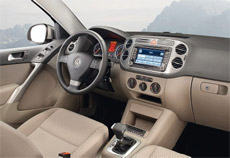
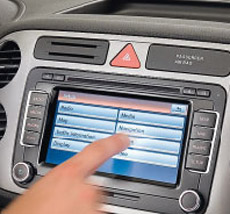
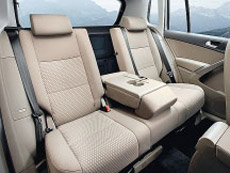
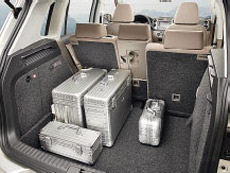
VOLKSWAGEN TIGUAN VIDEO VIDEO COMPANY since 2008
VOLKSWAGEN TIGUAN Crash Video since 2008
Volkswagen Tiguan test drives since 2008
Volkswagen Tiguan crash test since 2008
Krassh Test: Detailed Information34%
Driver and passengers
17%
Pedestrians
39%
Children-passengers

